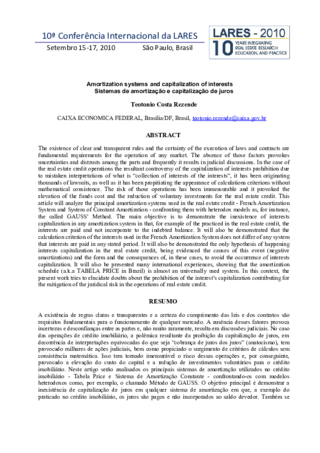A existência de regras claras e transparentes e a certeza do cumprimento das leis e dos contratos são requisitos fundamentais para o funcionamento de qualquer mercado. A ausência desses fatores provoca incertezas e desconfianças entre as partes e, não muito raramente, resulta em discussões judiciais. No caso das operações de crédito imobiliário, a polêmica resultante da proibição da capitalização de juros, em decorrência de interpretações equivocadas do que seja “cobrança de juros dos juros” (anatocismo), tem provocado milhares de ações judiciais, bem como propiciado o surgimento de critérios de cálculos sem consistência matemática. Isso tem tornado imensurável o risco dessas operações e, por conseguinte, provocado a elevação do custo do capital e a redução de investimentos voluntários para o crédito imobiliário. Neste artigo serão analisados os principais sistemas de amortização utilizados no crédito imobiliário - Tabela Price e Sistema de Amortização Constante - confrontando-os com modelos heterodoxos como, por exemplo, o chamado Método de GAUSS. O objetivo principal é demonstrar a inexistência de capitalização de juros em qualquer sistema de amortização em que, a exemplo do praticado no crédito imobiliário, os juros são pagos e não incorporados ao saldo devedor. Também se demonstrará que o critério de cálculo dos juros utilizados na Tabela Price em nada difere de qualquer sistema em que os juros são pagos em seus vencimentos. Será demonstrada, também, a única hipótese de ocorrer capitalização de juros no crédito imobiliário, evidenciando-se as causas deste evento (amortizações negativas) e a forma e as conseqüências de, nestes casos, evitar a ocorrência de capitalização de juros. Serão apresentadas, também, várias experiências internacionais, demonstrando que a Tabela Price é um sistema praticamente universal. Neste contexto, o presente trabalho procura elucidar as dúvidas relativas à proibição da capitalização de juros e, assim, contribuir para a mitigação do risco jurídico nas operações de crédito imobiliário.
The existence of clear and transparent rules and the certainty of the execution of laws and contracts are fundamental requirements for the operation of any market. The absence of those factors provokes uncertainties and distrusts among the parts and frequently it results in judicial discussions. In the case of the real estate credit operations the resultant controversy of the capitalization of interests prohibition due to mistaken interpretations of what is “collection of interests of the interests”, it has been originating thousands of lawsuits, as well as it has been propitiating the appearance of calculations criterions without mathematical consistence. The risk of those operations has been immeasurable and it provoked the elevation of the funds cost and the reduction of voluntary investments for the real estate credit. This article will analyze the principal amortization systems used in the real estate credit - French Amortization System and System of Constant Amortization - confronting them with heterodox models as, for instance, the called GAUSS’ Method. The main objective is to demonstrate the inexistence of interests capitalization in any amortization system in that, for example of the practiced in the real estate credit, the interests are paid and not incorporate to the indebted balance. It will also be demonstrated that the calculation criterion of the interests used in the French Amortization System does not differ of any system that interests are paid in any stated period. It will also be demonstrated the only hypothesis of happening interests capitalization in the real estate credit, being evidenced the causes of this event (negative amortizations) and the form and the consequences of, in these cases, to avoid the occurrence of interests capitalization. It will also be presented many international experiences, showing that the amortization schedule (a.k.a TABELA PRICE in Brazil) is almost an universally used system. In this context, the present work tries to elucidate doubts about the prohibition of the interest’s capitalization contributing for the mitigation of the juridical risk in the operations of real estate credit.
